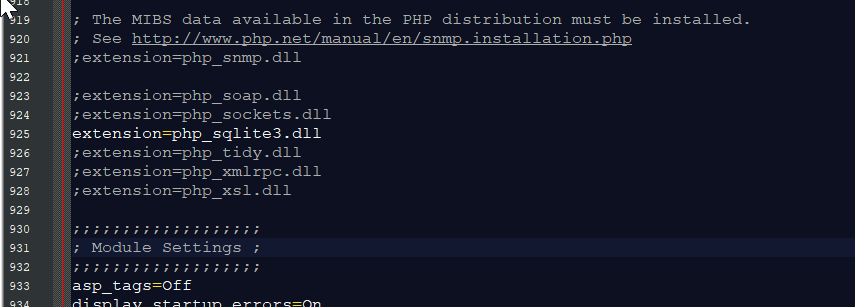Inserting Data into SQLite Database Using PHP PDO
In this tutorial we will create a Insert Data to SQLite Using PDO. PHP is a server-side scripting language designed primarily for web development. SQLite provides an interface for accessing the database. It includes class interfaces to the SQL commands. And also it allows you to create SQL functions and aggregate using PHP.
So Let's do the coding...Getting started:
First you have to download & install XAMPP or any local server that run PHP scripts. Here's the link for XAMPP server https://www.apachefriends.org/index.html.
And this is the link for the jquery that i used in this tutorial https://jquery.com/.
Lastly, this is the link for the bootstrap that i used for the layout design https://getbootstrap.com/.
Installing SQLite Browser
We will now then install the SQLite data viewer, here's the link for the DB Browser for SQLite http://sqlitebrowser.org/.Setting Up SQLite
First, we are going to enable SQLite 3 in our PHP.
- Open localhost server folder XAMPP, etc and locate php.ini.
- Open php.ini and enable sqlite3 by removing the semicolon in the line.

- Save changes and Restart Server.
Creating the database connection
In your source code folder create a new folder naming "db". This will be the folder where your sqlite database file will be located. Then, open your any kind of text editor(notepad++, etc..). Then just copy/paste the code below then name it conn.php.
- <?php
- $conn = new PDO('sqlite:db/db_member.sqlite3');
- $conn->setAttribute(PDO::ATTR_ERRMODE, PDO::ERRMODE_EXCEPTION);
- $query = "CREATE TABLE IF NOT EXISTS member (mem_id INTEGER PRIMARY KEY AUTOINCREMENT NOT NULL, firstname TEXT, lastname TEXT, address TEXT)";
- ?>
Creating The Interface
This is where we will create a simple form for our application. To create the forms simply copy and write it into you text editor, then save it as index.php.
- <!DOCTYPE html>
- <html lang="en">
- <head>
- <meta charset="UTF-8" name="viewport" content="width=device-width, initial-scale=1"/>
- <link rel="stylesheet" type="text/css" href="css/bootstrap.css"/>
- </head>
- <body>
- <nav class="navbar navbar-default">
- <div class="container-fluid">
- <a class="navbar-brand" href="https://sourcecodester.com">Sourcecodester</a>
- </div>
- </nav>
- <div class="col-md-3"></div>
- <div class="col-md-6 well">
- <h3 class="text-primary">PHP - Insert Data to SQLite Using PDO</h3>
- <hr style="border-top:1px dotted #ccc;"/>
- <button type="button" class="btn btn-success" data-toggle="modal" data-target="#form_modal"><span class="glyphicon glyphicon-plus"></span> Add Member</button>
- <br /><br />
- <table class="table table-bordered">
- <thead class="alert-info">
- <tr>
- <th>Firstname</th>
- <th>Lastname</th>
- <th>Address</th>
- </tr>
- </thead>
- <tbody style="background-color:#fff;">
- <?php
- require 'conn.php';
- $query = $conn->prepare("SELECT * FROM `member` ORDER BY `lastname` ASC");
- $query->execute();
- while($fetch = $query->fetch()){
- ?>
- <tr>
- <td><?php echo $fetch['firstname']?></td>
- <td><?php echo $fetch['lastname']?></td>
- <td><?php echo $fetch['address']?></td>
- </tr>
- <?php
- }
- $conn = null;
- ?>
- </tbody>
- </table>
- </div>
- <div class="modal fade" id="form_modal" aria-hidden="true">
- <div class="modal-dialog">
- <div class="modal-content">
- <form method="POST" action="save_member.php">
- <div class="modal-header">
- <div class="modal-title">
- <h3>Add Member</h3>
- </div>
- </div>
- <div class="modal-body">
- <div class="col-md-2"></div>
- <div class="col-md-8">
- <div class="form-group">
- <label>Firstname</label>
- <input type="text" name="firstname" class="form-control" required="required"/>
- </div>
- <div class="form-group">
- <label>Lastname</label>
- <input type="text" name="lastname" class="form-control" required="required"/>
- </div>
- <div class="form-group">
- <label>Address</label>
- <input type="text" name="address" class="form-control" required="required"/>
- </div>
- </div>
- </div>
- <div style="clear:both;"></div>
- <div class="modal-footer">
- <button class="btn btn-primary" name="save"><span class="glyphicon glyphicon-save"></span> Save</button>
- <button type="button" class="btn btn-danger" data-dismiss="modal"><span class="glyphicon glyphicon-remove"></span> Close</button>
- </div>
- </form>
- </div>
- </div>
- </div>
- <script src="js/jquery-3.2.1.min.js"></script>
- <script src="js/bootstrap.js"></script>
- </body>
- </html>
Creating the Main Function
This code contains the main function of the application. This code will store the data inputs to the SQLite database using PDO queries. To do this just copy and write these blocks of codes as shown below inside the text editor and save it as save_member.php.
- <?php
- require_once 'conn.php';
- $firstname = $_POST['firstname'];
- $lastname = $_POST['lastname'];
- $address = $_POST['address'];
- $query = "INSERT INTO member (firstname, lastname, address) VALUES (:firstname, :lastname, :address)";
- $stmt = $conn->prepare($query);
- $stmt->bindParam(':firstname', $firstname);
- $stmt->bindParam(':lastname', $lastname);
- $stmt->bindParam(':address', $address);
- $stmt->execute();
- $conn = null;
- }
- ?>
There you have it we successfully created an Insert Data to SQLite Using PDO. I hope that this simple tutorial helps you to what you are looking for. For more updates and tutorials just kindly visit this site.
Enjoy Coding!!!
